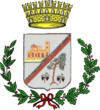Dolianova facts for kids
Quick facts for kids
Dolianova
Patiolla
|
||
|---|---|---|
| Comune di Dolianova | ||

Church of San Pantaleo
|
||
|
||
| Country | Italy | |
| Region | Sardinia | |
| Province | South Sardinia | |
| Area | ||
| • Total | 84.60 km2 (32.66 sq mi) | |
| Elevation | 212 m (696 ft) | |
| Population
(December 31, 2004)
|
||
| • Total | 8,223 | |
| • Density | 97.199/km2 (251.743/sq mi) | |
| Demonym(s) | Dolianovesi | |
| Time zone | UTC+1 (CET) | |
| • Summer (DST) | UTC+2 (CEST) | |
| Postal code |
09041
|
|
| Dialing code | 070 | |
| Patron saint | San Pantaleo and San Biagio | |
Dolianova (which is called Patiolla in the local Sardinian language) is a town and comune (a type of municipality) in Sardinia, Italy. It is located in the Province of South Sardinia. The town was formed on June 25, 1905. It came about when two older villages, Sicci San Biagio and San Pantaleo, joined together.
Dolianova's main way of making money is through agriculture. They are especially known for producing wine and olive oil. The name "Dolianova" has a bit of a mystery around it. Some people think it comes from the Latin words "Pars Olea," which means "Place of Oil."
History of Dolianova
The first records mentioning the area of Dolianova go back to the year 1089. At that time, a bishop named Virgilio signed a document. This document was about starting new monasteries, which were built because a ruler from Cagliari wanted them.
For a long time, the two villages that make up Dolianova, San Pantaleo and Sicci San Biagio, had different paths. San Pantaleo became an important center in the area. Its leaders had power over nearby villages like Donori and Soleminis.
The smaller village of Sicci San Biagio was controlled by different noble families. It remained under their rule until the old system of feudalism ended. By 1846, San Pantaleo had about 1,360 people, while Sicci had 727.
Today, the two old villages of San Pantaleo and Sicci San Biagio are the main parts of modern Dolianova. They used to be separated by large gardens, which are now home to the "Sa Mola de su Notariu" oil museum.
Main Sights
Dolianova has many interesting places to visit, showing its long history.
- The Cathedral of San Pantaleo: This is a beautiful church built in the Romanesque-Pisane style. Work on it started in 1160 and finished in 1289. It has been an important church since the 1300s.
- Roman Baths: You can find the remains of old Roman baths in an area called Sa Cora. These were public bathhouses used by people long ago.
- Nuraghe sa dom'e S'Orcu: This is an ancient stone structure called a Nuraghe. It's located in Punta Bruncu Salamu and shows how people lived thousands of years ago in Sardinia.
- The Giant's Tombs: In Su Tiriaxiu, you can see ancient burial sites known as Giant's Tombs. These are large, impressive tombs from the Bronze Age.
- Nuragic structures in Sant'Uanni: There are more ancient Nuragic buildings in Sant'Uanni. Their old fortresses are now covered by trees.
- Archaeological sites: Other important old sites include Mitza salamu and Sa dom’ ‘e s’ossu. These places give us clues about the people who lived here in ancient times.
Culture
The most important events in Dolianova celebrate its two patron saints. These saints are linked to the old villages of San Pantaleo and Sicci San Biagio.
One special event involves a procession through the streets. People carry a statue of the saint and a very large candle called Su Xeru. This candle is taken to Saint Mary's church in Siurgus Donigala. This tradition remembers a promise made long ago to protect the town from a plague.
Notable residents
- Graziano Origa (1952–2023), a famous artist.
See also
 In Spanish: Dolianova para niños
In Spanish: Dolianova para niños


